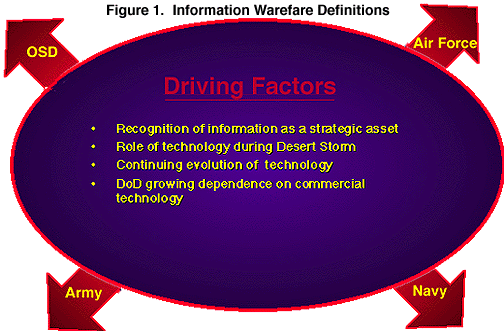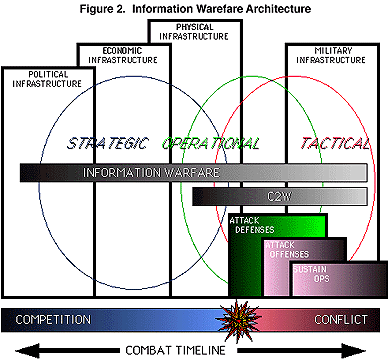






|

 

|

|
Information Warfare. It's been THE buzzword within the Department of Defense (DoD) for the last two years but what is Information Warfare (IW)? You could ask 100 people for a definition of Information Warfare and probably get the same number of different definitions. The purpose of this article is to provide a brief introduction to Information Warfare and some insight into this evolving paradigm which has had a revolutionary effect within DoD on how battles will be fought in the future.
Two visionaries often cited in the discussion of Information Warfare are Alvin and Heidi Toffler, noted "futurists" and authors of "War and Anti-War" (1993). The Toffler's describe evolutionary changes in society's ability to wage war and have characterized these changes in "waves".
First wave warfare was based upon an agrarian society where conflict was centered around agriculture, and where weaponry was primitive and powered by human muscle. Second wave warfare was introduced with the industrial age where weaponry was standardized and produced in mass quantities. Along with mass production came mass destruction. Third wave warfare is focused on knowledge and information as the foundation of the economy. The destruction of the Iraqi command and control infrastructure and the use of precision weapons during OPERATION DESERT STORM are examples of third wave warfare. Much of the discussion of Information Warfare is representative of third wave warfare. There have been several factors attributed to the focus on Information Warfare. First, the recognition of information as a strategic asset has caused military planners reassess the dynamics of the battlefield. A second factor is the lessons-learned from OPERATION DESERT STORM which saw the success of technology-based weapons on the battlefield (e.g., precision-guided munitions [PGMs]). Another factor is the advances in information technology and their potential application on the battlefield. A fourth factor is DoD's growing dependence upon commercial technology and the vulnerabilities associated with the integration of that technology within DoD.
There are several definitions of Information Warfare that have been formulated and disseminated throughout DoD. A sample of definitions is provided in Figure 1 along with the driving factors toward Information Warfare. A common thread amongst all the definitions is the PROTECTION of your information systems and the ATTACK and EXPLOITATION of an adversary's information system with the goal of attaining the advantage for information operations.

Information Warfare has far reaching effects. As shown in Figure 2, Information Warfare includes not only the traditional military targets but political and civilian infrastructure as well. Command and Control Warfare (C2W) is the military application of Information Warfare. Command and Control Warfare is defined as "the integrated use of operations security (OPSEC), military deception, psychological operations (PSYOP), electronic warfare (EW) and physical destruction, mutually supported by intelligence, to deny information to, influence, degrade or destroy adversary C2 capabilities, while protecting friendly C2 capabilities against such actions".1
Our growing dependence on technology has also heightened the awareness of the vulnerabilities to U.S. information systems. Information systems are vulnerable to attack and exploitation from curious students to individual hackers to coordinated and organized groups/adversaries. With the explosion in the use of the internet, this potential threat is both domestic and foreign (i.e., loss of sanctuary). The security concerns include such threats as network intrusions, software viruses, and trojan horses.

The purpose of this article was to provide a brief introduction to Information Warfare. It's difficult to expand upon this subject within the constraints of space for this article but the technologies applicable to Information Warfare are often characterized within the context of PROTECT, ATTACK and EXPLOIT. The revolution in technology has resulted in significant advances in the conduct of military operations and has raised the awareness of the vulnerabilities to our own information systems. The study of Information Warfare continues as DoD seeks to grasp it's full potential and it's application in the support of national security objectives.

|

 

|

|